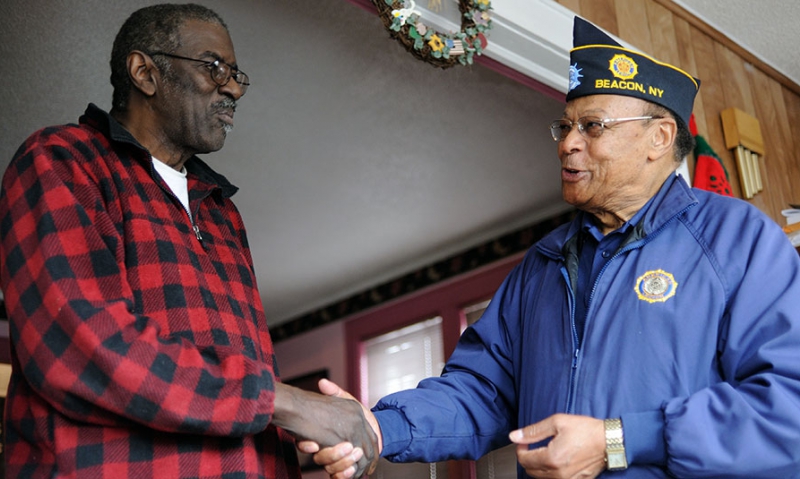
'Better bang for your buck'
Earlier this winter, Department of Wisconsin 7th District Commander Mark Lesko spent three days in Sparta, Wis., reaching out to former Legion members and current members of the department’s headquarters, or holding, post.
Lesko’s efforts were part of a revitalization effort aimed at building the membership at each of the district’s posts. Conducting a revitalization effort makes sense, as opposed to focusing on a single post, and is better return on investment, the Paid-Up-For-Life member said. And it adds something special to the membership effort.
“You get bigger bang for your buck,” Lesko said. “You can’t rely on one (post). And it’s a rivalry (between posts and districts) that you get going. We have fun.”
District revitalization efforts have become the norm for many reasons. “We have found that by working at the district level, we can train a cadre of dedicated leaders in the process of revitalization; a process they can then carry back to the individual posts within their districts and (to) other districts in their departments,” National Membership & Post Activities Committee Chairman Kenneth Orrock said. “An additional benefit is the ability to maximize the number of DMS (Direct Mail Solicitation) and headquarters post members moved into active posts. Often times we see six or more posts within a district that open their doors to not only new members attracted to the organization through the publicity and activities of a revitalization open house, but also to those members being transferred in."
Revitalization efforts earlier this year in Wisconsin, Ohio and Connecticut resulted in more than 240 former department headquarters post or new members placed into local Legion posts.
Department of Connecticut Commander Paul Spedaliere said that there can be a misconception when someone joins the Legion through either the DMS program or online. “You join The American Legion (either of those ways) and a lot of people think they’re already part of the (post) where they live,” he said. “(In a post), you’re a veteran in your community. The heart of The American Legion is the post.”
Department of Connecticut Senior Vice Commander Louie Robinson said he believes that most members who are members of the department headquarters post want to be a part of a local post. “But nobody ever asked them before,” he said. “Once somebody talks to them and lets them know The American Legion is not just a donation you make … (they say) I’ll try it.”
Acting Ninth District Commander William Dittebrand saw similar reactions during a revitalization effort in his department. “It’s eye-opening and very interesting – especially when you talk to some of these (headquarters) post members … and they were very thankful they got the phone call,” he said. “They had no issues with joining the (local) post.”
Departments and national staff begin coordinating revitalization efforts two to three months in advance and designate points-of-contact at the department and/or district level to ensure that every post in the district knows of the effort.
Determining host sites is done based on several criteria, including service officer availability. Having a service officer available to former, current and prospective members is critical in the eyes of Richard Linnon, who is a service officer while also holding down the roles of Department of Connecticut vice commander and the First District commander.
“Veterans Affairs & Rehabilitation – to me, that’s what the Legion is all about,” said Linnon, who assisted veterans with Department of Veterans Affairs-related issues during the Connecticut revitalization effort in January. “I’ve done this at several other district revitalizations. We’re here to help the veterans that are in need of services and do what we can.”
As the revitalization draws closer, advance media notification takes place, including via social media, while a post card with the details of the revitalization effort is mailed out to former, expired and headquarters post members.
A brief training session and briefing normally takes place at the start of the effort. Most revitalizations use a two-pronged approach: making phone calls and going door to door. National provides samples of phone scripts, as well as various American Legion media brochures and booklets.
Legionnaires from all over the district work side by side for multiple days, which Department of Ohio Ninth District Second Vice Commander William Keller said is one of the highlights of the effort.
“It gives us all a greater bonding as veterans and gives us a chance to know each other a whole lot better,” Campbell said. “We understand each other because we’re all there for the same reason: to serve our country.”
Bill Binnebase, first vice commander at Post 417 in French Island, Wis., agreed. “You get to know people from other posts,” he said. “You get to work with them. You can share ideas and do some brainstorming.”
And, those who take part in revitalizations are quick to admit, it’s fun working together to grow The American Legion while serving veterans.
“Having participated in district revitalizations across the country, I can tell you they are a lot of fun,” Orrock said. “The satisfaction you get from a successful revitalization effort and continuing to serve our fellow veterans is incredible."
To set up a district revitalization in your state, contact your department headquarters.
